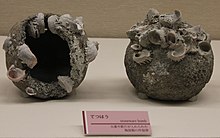Thunder crash bomb


The thunder crash bomb (Chinese: 震天雷; pinyin: zhèntiānléi) is an early type of bomb or hand grenade developed in the 12th-13th century Song and Jin-era China. Its shell was made of cast iron and filled with gunpowder. The length of the fuse could be adjusted according to the intended throwing distance.
